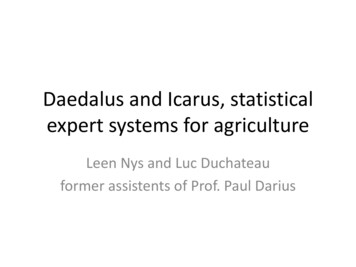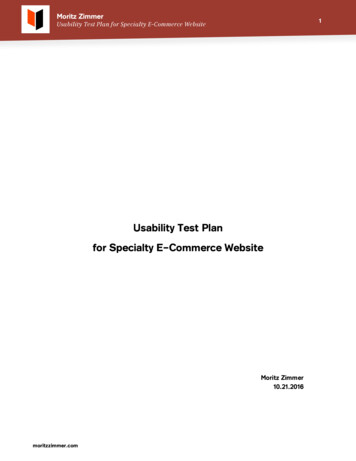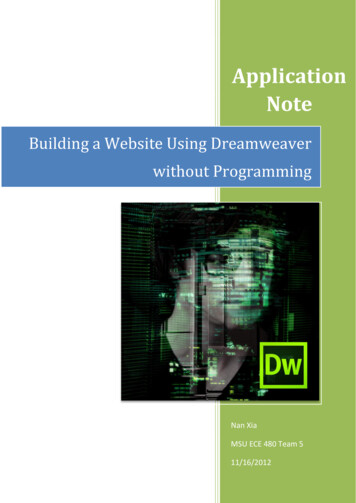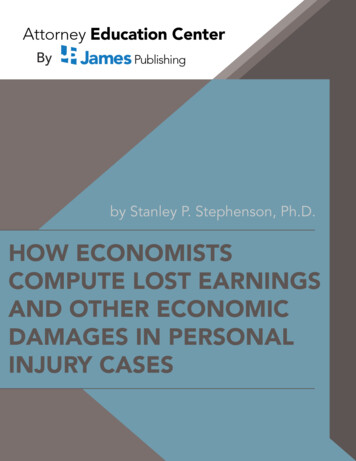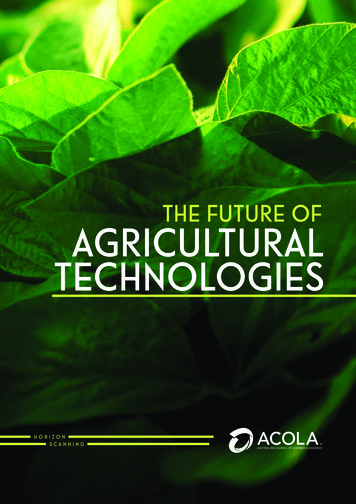
Transcription
EXPERT WORKING GROUPProfessor Stewart Lockie FASSA (Chair, September 2019 – December 2019)Dr Kate Fairley-Grenot FAICD FTSE (Chair, November 2018 – September 2019)Professor Rachel AnkenyProfessor Linda Botterill FASSAProfessor Barbara Howlett FAAProfessor Alex McBratney FAAProfessor Elspeth Probyn FAHA FASSAProfessor Tania Sorrell AM FAHMSProfessor Salah Sukkarieh FTSEProfessor Ian Woodhead Australian Council of Learned Academies (ACOLA)ISBN 978-0-6483303-4-9 (print)ISBN 978-0-6483303-5-6 (digital)This work is copyright. All material published or otherwise created bythe Australian Council of Learned Academies (ACOLA) is licensed undera Creative Commons – Attribution – Non-Commercial 4.0 International(CC BY-NC 4.0) licence.DATE OF PUBLICATIONSeptember 2020PUBLISHERAustralian Council of Learned AcademiesLevel 6, 436 St Kilda RoadMelbourne Victoria 3004 AustraliaTelephone: 61 (0)3 9864 0923www.acola.orgREPORT DESIGNLyrebirdjo@lyrebirddesign.comSUGGESTED CITATIONLockie, S., Fairley-Grenot, K., Ankeny, RA., Botterill, LC., Howlett, BJ.,McBratney, AB., Probyn, E., Sorrell, TC., Sukkarieh, S., Woodhead, I., (2020)The future of agricultural technologies. Report for the Australian Councilof Learned Academies, www.acola.org.ACKNOWLEDGEMENT OF COUNTRYACOLA acknowledges the Traditional Owners and custodians of the landson which our company is located and where we conduct our business.We pay our respects to Elders past, present and emerging.ii
AUTHORSProfessor Stewart Lockie FASSADr Kate Fairley-Grenot FAICD FTSE (December 2018 – September 2019)Professor Rachel AnkenyProfessor Linda Botterill FASSAProfessor Barbara Howlett FAAProfessor Alex McBratney FAAProfessor Elspeth Probyn FAHA FASSAProfessor Tania Sorrell AM FAHMSProfessor Salah Sukkarieh FTSEProfessor Ian WoodheadSupported by Michelle Steeper, Dr Emily Finch, Dr Lauren Palmer,Ryan Winn and the generous contributions of many expertsthroughout Australia and New Zealand. A full list of contributorscan be found in the written submissions section of the report.PROJECT MANAGEMENTDr Lauren PalmerRyan Winniii
Working TogetherThe Australian Council of Learned Academies (ACOLA) combinesthe strengths of the Australian Learned AcademiesThe Academy of the Social Sciences in Australia (ASSA) promotes excellencein the social sciences and in their contribution to public policy.The social sciences are a group of like-minded academic disciplines that work on systematicdevelopment of logic and evidence to understand human behaviour in its social setting,including the nature of economic, political, and community activity and institutions.ASSA is an independent, interdisciplinary body of over 650 Fellows, elected by their peersfor their distinguished achievements and exceptional contributions across 18 disciplines.ASSA coordinates the promotion of research, teaching and advice in the social sciences, promotes nationaland international scholarly cooperation across disciplines and sectors, comments on national needs andpriorities in the social sciences and provides advice to government on issues of national importance.Established in 1971, replacing its parent body the Social Science Research Council of Australia,founded in 1942, ASSA is an autonomous, non-governmental organisation, devotedto the advancement of knowledge and research in the various social sciences.www.assa.edu.auThe Australian Academy of Technology and Engineering is an independent thinktankthat helps Australians understand and use technology to solve complex problems.We bring together Australia’s leading experts in technology, engineering and science to provide impartial,practical and evidence-based advice on how to achieve sustainable solutions and advance prosperity.We champion STEM excellence and contribute robust and practical thinking to Australia’sbig debates. Like you, we’re curious about the world and want to create a better future.We are a Learned Academy made up of almost 900 Fellows elected by their peers.www.applied.org.au
By providing a forum that brings together great minds,broad perspectives and knowledge, ACOLA is thenexus for true interdisciplinary cooperation to developintegrated problem solving and cutting edge thinking onkey issues for the benefit of Australia. www.acola.orgThe Australian Academy of Science (AAS) is a private organisation established by Royal Charter in 1954. It comprisesmore than 500 of Australia’s leading scientists, elected for outstanding contributions to the life sciences and physicalsciences. The Academy recognises and fosters science excellence through awards to established and early careerresearchers, provides evidence-based advice to assist public policy development, organises scientific conferences,and publishes scientific books and journals. The Academy represents Australian science internationally, throughits National Committees for Science, and fosters international scientific relations through exchanges, eventsand meetings. The Academy promotes public awareness of science and its school education programs supportand inspire primary and secondary teachers to bring inquiry‑based science into classrooms around Australia.www.science.org.auThe Australian Academy of the Humanities (AAH) is the national body for the humanities in Australia,championing the contribution that humanities, arts and culture make to national life. It provides independentand authoritative advice, including to government, to ensure ethical, historical and cultural perspectivesinform discussions regarding Australia’s future challenges and opportunities. It promotes and recognisesexcellence in the disciplines that provide the nation’s expertise in culture, history, languages, linguistics,philosophy and ethics, archaeology and heritage. The Academy plays a unique role in promoting internationalengagement and research collaboration, and investing in the next generation of humanities researchers.www.humanities.org.auASSOCIATE MEMBERThe Australian Academy of Health and Medical Sciences is the impartial, authoritative, cross-sector voice of health andmedical science in Australia. We are an independent, interdisciplinary body of Fellows – elected by their peers for theiroutstanding achievements and exceptional contributions to health and medical science in Australia. Collectively, theyare a representative and independent voice, through which we engage with the community, industry and governments.The Academy is uniquely positioned to convene cross‑sector stakeholders from across Australia to address the mostpressing health challenges facing society. We focus on the development of future generations of health and medicalresearchers, on providing independent advice to government and others on issues relating to evidence based medicalpractice and medical researchers, and on providing a forum for discussion on progress in medical research with anemphasis on translation of research into practice.www.aahms.orgACOLA receives funding from the Australian Government Department of Education, Skills and Employment.
HORIZONSCANNINGSERIESWe live in a time of rapid change; change that is driven bydevelopments in science and technology and challenged byour capacity to adapt in the present and prepare for the future.Commissioned by Australia’s Chief Scientist, on behalf of theNational Science and Technology Council, Horizon Scanningreports present independent and timely analyses to guidedecision makers through the decade ahead.Horizon Scanning reports by the Australian Council of Learned Academies(ACOLA) draw on the deep disciplinary expertise from within Australia’sLearned Academies to analyse the future, navigate change and highlightopportunities for the nation. As interdisciplinary studies, ACOLA’s reportsinclude economic, social, cultural and environmental perspectivesto provide well-considered findings that inform complete policyresponses to significant scientific and technological change.This project has been supported by the Australian Governmentthrough the Department of Agriculture, Water and the Environment.ACOLA collaborates with the Australian Academy of Health andMedical Sciences and the New Zealand Royal Society Te Apārangi todeliver the interdisciplinary horizon scanning reports to Government.Also in the Horizon Scanning SeriesThe role of energy storage in Australia’s future energy supply mixPublished 2017The future of precision medicine in AustraliaPublished 2018Synthetic biology in Australia: An outlook to 2030Published 2018The effective and ethical development of artificial intelligence:An opportunity to improve our wellbeingPublished 2019vi
vii
CONTENTSNote from the Expert Group ChairProject aims1Executive summary2Key findings8Introduction12Chapter 1: Australian agriculture: challenges and opportunities161.1Broader socio-politico context of the agriculture sector161.2Agriculture and the Indigenous estate181.31.4Broader trends and pressures facing Australian agriculture2.12.22.32.4Climate variability and environmental and landscape sustainability191.3.2Industry and global disruptions and changing consumer preferences211.3.3Biosecurity and food safety231.3.4Cost of productionTurning agriculture’s challenges into opportunitiesSensors and the Internet of Things242526292.1.1Sensors292.1.2Internet of Things33Automation management technologies352.2.1Robotics352.2.2Machine learning382.2.3Large-scale optimisation and data fusion39Biotechnology (omics and synthetic biology) and nanotechnology412.3.1Breeding and modifying crops for resilience432.3.2Breeding, modifying or editing crops to enhance value452.3.3Adapting to consumer preferences and creating new commodities462.3.4Modifying livestock for improved resilience482.3.5Enhancing biosecurity and food safetyTransactional technology2.4.12.5191.3.1Chapter 2: Advanced technologies and Australian agricultureviiixiiDistributed ledger technologyApproaching the adoption of new technologies49505053
Chapter 3: Factors shaping the uptake of technology in agriculture3.13.23.3Enablers of technology adoption54553.1.1Adoption by primary producers563.1.2Acceptance by consumers583.1.3Empowering regional communities593.1.4Good design and explainability643.1.5Research, development and extension65Legal, regulatory and economic considerations663.2.1Introduction to regulatory considerations663.2.2Sharing the benefits673.2.3Data ownership, sharing and privacy673.2.4Commercialisation and intellectual property713.2.5Ownership and leasing rights for farm equipment713.2.6Changes to regulatory frameworks and risk assessments723.2.7Autonomous monitoring and reporting for government723.2.8Economic opportunities73Roles and responsibilities of governments and industry743.3.1The role of governments743.3.2The role of industry753.3.3Shared responsibilities75Conclusion76Appendix 1: Technology selection methodology78Appendix 2: Terms of reference80Appendix 3: Farm numbers and size82Abbreviations83Glossary84References86Expert Working Group94Peer Review Panel98Evidence Gathering100Acknowledgements102ix
FIGURESFigure 1: The risk and benefit perception categories thatinfluence acceptance or rejection of novel food technologies.22Figure 2: Categories of sensors in the context of agriculture.30Figure 3: Hyperspectral image sensing of crop health.32Figure 4: Defining aspects of the IoT.33Figure 5: Technologies used within robotic systems in agriculture.35Figure 6: Applications of biotechnology and nanotechnologyand their outcomes for agriculture.42Figure 7: Digitisation of the food supply chain,supported by blockchain technology.51Figure 8: Digital capability framework.61Figure 9: Schematic of the impact graph used in the ACOLA process.79Figure 10: Farm numbers, farm size and area of agriculturalland between 1982-83 and 2002-03.82TABLESTable 1: Existing adaptive responses to climate variability in Australian agriculture. 21Table 2: Management responses to biosecurity threats in Australian agriculture.23Table 3: Existing and potential applications of advanced technologyin Australian agriculture.28Table 4: Major intersections between the identified technologyareas and trends and pressures.28Table 5: Factors determining or enabling uptake of technologyin the agriculture sector.54
BOXESBox 1: Farms adapting to climate variability20Box 2: Advanced management of cattle and buffaloin the northern Indigenous estate30Box 3: Sensors in aquaculture32Box 4: IoT and orchard management34Box 5: On-farm robotics37Box 6: Using climate resilient Indigenous plants for sustainable farm management44Box 7: ‘Methane-busting seaweed’ feed supplements46Box 8: Preventing culling of male chicks48Box 9: Provenance and traceability of beef53Box 10: Diversifying regional areas59
NOTE FROM THEEXPERT GROUP CHAIRIt is no accident most of the findingspresented in this report speak to leadershipand collaboration across the government,industry and research sectors if we areto realise the transformational potentialof advanced technology.We are confident that the future of agriculturein Australia will be one in which data analyticsand artificial intelligence are as at home onthe farm as they are in any other high‑techindustry – a future in which the use ofadvanced sensing, automation, the internet ofthings and other emerging technologies is nomore remarkable than tractors and quad bikesare today.Advanced technologies open possibilities forAustralian agriculture beyond incrementalgains in production and labour productivity.These include genuinely transformationalapproaches to managing capital, plant andlivestock, natural resources, biosecurityand supply chains to better deal withclimatic and market variability. They includepossibilities to commercialise new products,differentiate Australian produce in theglobal market, verify its provenance andquality, and lift the profitability of agriculturewhile protecting social, cultural, healthand environmental values.xiiThere is a great deal to be optimisticabout but there are risks too that shouldbe managed. Perhaps the most obvious ofthese are consumer resistance to productsperceived as unethical. Farm businesses mustalways play the balancing act between ratesof return on capital and investment into newtechnology and this is particularly difficultfor less profitable industries.Of more concern to the Expert WorkingGroup is the risk that change in theAustralian agriculture sector will not be quickenough, or substantial enough, to deal withclimate‑induced shocks and intensifyingglobal competition.Sustained engagement is needed withurban and rural communities alike to ensureagriculture maintains its ‘licence to operate’and attracts skills and investment to serviceadvanced technology.Professor Stewart Lockie FASSA
PROJECT AIMSThe aim of this horizon scan is to examineand understand the impacts, opportunitiesand challenges associated with around tenhighly prospective technologies likely toimpact agriculture over the next ten yearsand consider how Australian agriculture ispositioned to meet them. This will includeconsideration of the role these technologiescan play in helping Australian agricultureaddress the broader trends and pressuresfacing it, including: climate variability and resilience changing consumer preferences workforce capacity environmental and landscapesustainabilityEach technology will be analysed withinthe following framework: What transformative role could thetechnology play in the agricultural sector? What are the social, cultural, economic,legal and regulatory implications ofthe technology? What is the role of ‘big data’ in thetechnology? Where relevant, examineissues of data integrity and standardsand security and privacy. What is the role for government andindustry in addressing challenges andfacilitating uptake of opportunities,presented by the technology? biosecurity industry disruption costs of production.1
EXECUTIVESUMMARYAustralian agriculture is world-renowned for leadership in harvesting practices,water-efficient agronomy, crop and livestock breeding, conservation tillageand development of fit-for-purpose farm machinery. While Australia exportstwo-thirds of its produce, it is a relatively small exporter when compared tocountries like the United States and the Netherlands (Howden & Zammit,2019). Nonetheless, our primary producers (or farmers) are among the mostefficient in the world, with a long history of productivity improvementand adaptation to external challenges, including environmental extremes,price fluctuations, variations in international trade conditions and changesin government policy. Farmers have embraced innovation and shownwillingness to adopt technologies that lead to improvements in farm practices.Governments, research providers and a range of other stakeholders have beencritical to ensuring that the appropriate resources, policies and institutionalarrangements are in place to support research, development and extension.However, new and transformationalapproaches will be needed for the agriculturesector to remain productive and competitivein a changing natural, social and economicenvironment. The development of advancedtechnologies is critical to this transformation,but it is not by itself sufficient. Ensuringthe suitability and adoption of advancedtechnologies requires consideration of thebroader economic, social and environmentalcontext for technology use.This Horizon Scanning report examinesimpacts, opportunities and challengesassociated with nine technologies: sensors,2internet of things (IoT ), robotics, machinelearning, large scale optimisation and datafusion, biotechnology, nanotechnology, anddistributed ledger technology.These technologies present opportunitiesto improve the efficiency and profitabilityof agricultural production, to developnovel agricultural industries and markets,and to contribute to a range of social andenvironmental values. Transformationalchange of this nature will most likely occurwhen multiple technologies are appliedtogether, and their integration is underwrittenby the power of big data and skilful analysis.
MethodologyA rigorous review process was conductedto explore key factors that could inform theadoption of future technologies, including thecontextual and historical background of theAustralian agriculture sector and the broadertrends and pressures that the industry is facing.As a result of this review process, technologieswere identified and examined against theirpotential to address broader trends andpressures over the next decade. Finally, thefactors likely to determine and enable theuptake of agricultural technologies wereinvestigated, including social, legal, regulatoryand economic considerations. The outcomesof these investigations are summarised below.Broader trendsand pressuresThe current prevailing drought across muchof Australia highlights the importance oftechnological innovation as one of a rangeof strategies for coping with climatic andmarket variability. Over the coming decade,the pace and direction of innovation arelikely to be influenced by: increasing prevalence and intensityof extreme weather events includingdroughts, floods, hail and frost asa consequence of climate change3
intensifying global competition asthe adoption of new technologies inother countries increases the relativeproductivity and quality of theiragricultural sectors biosecurity risks including exotic diseasesand pests increasing as a consequence ofclimate change, global travel and trade demands from domestic and internationalbuyers for assurance concerning thequality and safety of agricultural products,and the social and environmental impactsof agricultural products perceptions of risk associated with nontraditional methods of food production,which will influence consumer preferences.Responding to these trends while ensuring aprofitable and sustainable agricultural sectorwill demand step-changes in the productivityof Australia’s agricultural systems along withnew business models and the developmentof new food and fibre industries.Technology opportunitiesThe identified technologies may resultin novel products: including new traitsin existing crops and animals; new formsof nutrient-rich products; and the use ofmicrobes to produce high-value plantmetabolites for food and medical purposes.The deployment of advanced biotechnologysolutions and digital technologies anddevices will provide opportunities toincrease profitability and production, globalcompetitiveness, environmental quality,economic growth, and community wellbeing.4The deployment of advanced technologies,such as robotics, coupled with artificialintelligence (AI) and IoT, has the potentialto generate vast amounts of data that willbe transformational for farming practices,complex decision making and environmentalmonitoring. Advanced capabilities such asdata fusion and machine learning will benefitfarming practices and create new markets foron-farm capital – for example, through betterforecasting of weather and natural resourcestrategies. On-farm sensors, devices, roboticsand automation will allow agricultural workersto devote more time to complex tasks ratherthan to activities requiring low levels of skill.Data, AI and IoT, if properly harnessed, willunderpin many future farming capabilities,including asset automation and optimisation,supply chain optimisation, rapid testingof localised crops, and robotics. This willbe enabled and driven by a reductionin cost and the increasing capability ofcomputational hardware, memory andcommunications, coupled with increasinginvestment and capacity in software andalgorithm development.Sensors and blockchain technologiesemployed by primary producers, processorsand retailers will enable quality assuranceprograms to verify and communicate thequality and ethical attributes of products.This will lead to improved transparency of theenvironmental impacts, animal welfare andtreatment of workers for consumers.Biotechnologies have the potential to improvethe resilience of crops and livestock to climatevariability, pests and diseases. Gene editingprovides opportunities to cultivate new andimproved products in agriculture.
5
Creating an enabling environmentfor transformational changeThere will be a role for primary producers,government and industry to work togetherin establishing the environment that enablesthe development, uptake and success ofnew technologies.The adoption of advanced agriculturaltechnologies has the potential to providethe sector with new opportunities and tocontribute to the economic wellbeing ofregional and rural Australia. At the sametime, the potential for negative impacts on,for example, rural labour markets, should bemitigated through provision of educationand training opportunities.Attitudes to technology and its adoptionby primary producers are complex andmultifactorial. Australian primary producersneed a clear value proposition in order tobe willing to adopt the new technologies.In addition, new and emerging technologiesneed to be viewed as fit for purpose inthe Australian context, which will involvepartnerships between technology developers,researchers, farmers and the broadercommunity.6transparency and consultation betweenprimary producers, governments, industryand consumers to understand and raiseawareness of new technologies.Creating a national approach to the useof agricultural data will be a key enablerunderpinning many technologies. Relevantconsiderations include privacy, surveillanceand ownership of data between technologyusers and providers. Farmers should be activeparticipants in all discussions and decisionsin this domain.Telecommunications is a key enabler for manyprospective technologies. While regionaland rural telecommunication infrastructurehas improved over the last decade withnew technologies being developed, thereremain significant areas where connectivityis unreliable or suboptimal for the needs offuture technologies.Consumer and broader communityexpectations and concerns are increasinglyinfluencing the agricultural sector. Thesemust be understood, especially for geneFarmers already use a diverse range of skillsand expertise to manage their complexbusinesses, equipment and currenttechnology solutions. However, additionalskills will be needed to maximise the value ofnew technologies and ensure their reliability.For example, up skilling in data literacy andknowledge to maintain or repair sensors willbe essential to ensure the reliability and valuetechnologies. There is a need for greaterfrom on farm data streams.
The future of Australia’s agriculture sectorNew and emerging technologies have thepotential to assist the agriculture sector toovercome a number of challenges, generatenew products and market opportunities,increase rural and regional population, aswell as offer rural and regional communitieseconomic and community benefits, includingfor Aboriginal and Torres Strait Islanderbusinesses.No single emerging technology will solvethe challenges facing Australian agriculture.Supporting transformational change inagriculture requires both the creativecombination of multiple technologies andprovision of institutional, regulatory andcommunications infrastructure to enablecollaboration and innovation. Nationalleadership must: provide a platform for cross-sectoral andcross-disciplinary collaboration in research,development and innovation resolve regulatory and policy issuesincluding the use of agricultural data prioritise construction of critical enablinginfrastructure ensure sustained focus across theagricultural innovation system onlong‑term challenges and opportunities.There is a role for all stakeholders, includingthe community, in the future prosperity ofAustralia’s agricultural sector. Governments,academia and industry all have roles inassessing and responding to consumerand public perceptions and attitudes;engagement with communities abouttheir views and values relating to emergingtechnologies at all stages of the planningimplementation cycle will be necessary.Technology opens opportunities to explorenew products and markets along with newor modified production systems. This isparticularly important where agriculturalbusinesses struggle with low profitabilityand return on investment.Given the extent of landholdings now underAboriginal and Torres Strait Islander controlit is equally important that Indigenouslandholders participate in technologydevelopment and adoption. Additional workinvolving, and preferably led by, Indigenouslandholders, researchers and innovators willbe critical to understanding this opportunityand its implications for the broaderagricultural sector.This report builds on two previous ACOLAreports on artificial intelligence andsynthetic biology. The key findings identifycross‑cutting themes, activities and actionsto be considered in the developmentand application of new agriculturaltechnologies, which address key challengesand opportunities, while mitigating risks.This will contribute to a thriving agriculturesector that meets domestic and internationalrequirements over the coming decades andensures profitability while considering andaddressing social and environmental needs.7
KEY FINDINGS12Addressing the opportunities andchallenges facing Australian agriculturerequires transformative applicationof emerging technologies.Australia’s agricultural technology andinnovation ecosystem needs revitalisationto provide more opportunity forstakeholder involvement and to breakdown sectoral and disciplinary silos. Step-changes in productivity are requiredif Australian agriculture is to remainprofitable and sustainable. Revivingproductivity growth, which has slowedover the last two decades, will necessitateadoption of new technologies andpractices along with the developmentof new products and business models. Agriculture industries must work togetheras a cohesive sector to determine howbest to capture and integrate provenance,production and environmental informationto enhance product value and enablediversification, taking into account trendsin consumer values and preferences. Efforts are needed to increase thecapacity to adopt and adapt advancedtechnologies. Increased adoption couldhelp to ensure our agriculture sectorcan respond to particular nation specificchallenges with more drought resilientcrops, improved resource management,better understanding and prediction ofclimate variability, new and enhancedproducts, and improved on-farmdecision‑making.8 Future investment should more effectivelyleverage Australia’s existing expertise inresearch and development, continuinga substantial legacy of innovation inagriculture. While more investment isalways welcomed, the effectiveness ofinvestment will be substantially enhancedby building more synergistic relationshipsacross traditional sectoral boundaries andthrough multidisciplinary approaches tonational issues. The inclusion of primary producersand other community members in theinnovation ecosystem is critical to enabletimely identification and respond to theneeds and aspirations of end-users.
34The strength and resilience of Australia’sagricultural sector will be enhancedby supporting adoption of agriculturaltechnology by Indigenous landholders.Technology development and adoptionacross Australian agriculture shouldinclude explicit consideration ofbuyer preferences and expectations. The size of Indigenous estate suggeststhere is significant potential to realisemore economic value through theadoption of advanced technology byIndigenous landholders. Technology enabled enterprisediversification, improvement in land andwater management, and supply chaindevelopment in rural and remote Australiawill benefit both Indigenous and nonIndigenous businesses. Advanced technologies offer newopportunities to address buyer concernsabout the acceptability of someagricultural practices and to provideassurance, more broadly, that buyerexpectations can be met in a robustand t
Executive summary 2 Key findings 8 Introduction 12 Chapter 1: Australian agriculture: challenges and opportunities 16 1.1 Broader socio-politico context of the agriculture sector 16 1.2 Agriculture and the Indigenous estate 18 1.3 Broader trends and pressures facing Australian agricultu
